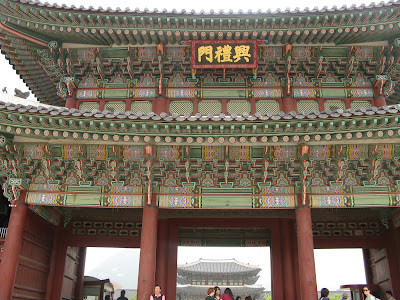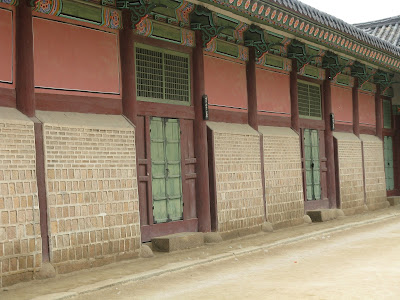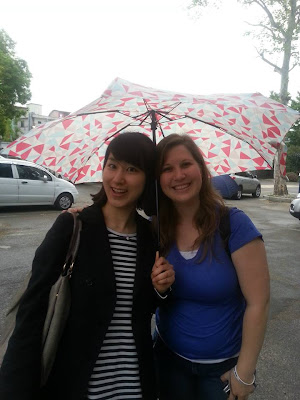Miscommunications caused by mispronunciation:
The "l" and "r" are interchangeable in the Korean language. In fact, many don't hear the difference. Here's an example of one of those instances.
In one of my English classes, I asked my student Brian to tell me what a certain picture was.
Brian: "Ryan"
Me: "No, not Ryan (another student in the class), Brian"
Brian: "Ryan"
Me: "No, I don't want Ryan to tell me, I want you to tell me"
Brian: Points at picture, "Ryan"
Me: Look at picture and realize that he was trying to say "lion"
Wednesday, June 26, 2013
Tuesday, June 18, 2013
Konglish
There are a lot of English words that are mixed into today's Korean vocabulary for example "coffee" or "computer." However, there are some words that even though they're English, they mean something else here in South Korea. Also, some of the words/expressions may be "English" but they actually don't exist in our English language. I thought I'd share some of them with you.
Konglish words that I've come across and what they mean:
Air Con = A/C (air conditioner)
Take a rest = combination of "take a break" and "get some rest"
Service = free of charge/"on the house"
Dessert = after-meal tea
Event = promotional event
Fancy = fancy stationary
Free size = one-size fits all
Glamour = buxom woman
Hiking = bicycling
Hot dog = corn-dog-style hot dog
I.D. = username
Meeting = blind date
Overeat = vomit/throw up
Pop song = English song
Ribbon = bow
Sharp = mechanical pencil
Name pen = marker
Toast = grilled omelet sandwich
Talent = TV star
Training = sweat suit
Underground = under-appreciated music
A/S (After Service) = Warantee service
American coffee = black coffee
Autobi(ke) = motorcycle
Back mirror = rear-view mirror
Cash corner = ATM
Eye shopping = window shopping
Ice bar = popsicle
Hand phone = cell phone
McGuyver knife = Swiss Army knife
Name card = business card
One-piece = dress
Sports dancing = ballroom dancing
Ball pen = ball point pen
D/C = discount
Magic = Magic Marker (permanent marker)
White = white out
Konglish words that I've come across and what they mean:
Air Con = A/C (air conditioner)
Take a rest = combination of "take a break" and "get some rest"
Service = free of charge/"on the house"
Dessert = after-meal tea
Event = promotional event
Fancy = fancy stationary
Free size = one-size fits all
Glamour = buxom woman
Hiking = bicycling
Hot dog = corn-dog-style hot dog
I.D. = username
Meeting = blind date
Overeat = vomit/throw up
Pop song = English song
Ribbon = bow
Sharp = mechanical pencil
Name pen = marker
Toast = grilled omelet sandwich
Talent = TV star
Training = sweat suit
Underground = under-appreciated music
A/S (After Service) = Warantee service
American coffee = black coffee
Autobi(ke) = motorcycle
Back mirror = rear-view mirror
Cash corner = ATM
Eye shopping = window shopping
Ice bar = popsicle
Hand phone = cell phone
McGuyver knife = Swiss Army knife
Name card = business card
One-piece = dress
Sports dancing = ballroom dancing
Ball pen = ball point pen
D/C = discount
Magic = Magic Marker (permanent marker)
White = white out
Saturday, June 8, 2013
Seoul Trip Part 2
Our second day in Seoul was just as busy as our first. We left our bags in a locker at the Seoul station, which was cheap and very convenient. It was a lot easier trekking around the city without lugging extra stuff with us. There are a few other subway stations in the city that have lockers as well. You can leave your stuff there all day without having to worry about safety.
We started off our second day in Seoul by going to Gyeongbokgung Palace. It was built in 1395 and was the main palace during the Joseon Dynasty. It was the main and largest palace of the five grand palaces built during the Joseon Period. Korea is in the middle of a 40 year initiative to restore and reconstruct the palace as all but 10 of its' hundreds of buildings were destroyed by Japan during their occupation of colonial Korea in the early 1900s. About 40% has been completed now.
We only got tickets to see the main palace as there was so much to see and our time there was limited. The basic ticket is 3.000 won while the ticket to see all the palaces is 10.000 won. We were there for a couple hours and didn't see half of what there was to see.
At Gwanghwamun Plaza, in front of Gyeongbokgung Palace. This statue is of Admiral Yi Sun-sin, who led Korea to victory during the Japanese invasions of Korea in the 1590's. There is a fountain in front of this statue to commemorate the 23 battles he fought with 12 warships.
In the courtyard, in front of the Throne Hall. The granite stones inthe courtyard were intentionally roughly hewn to reduce glare. Three footpath run through the center of the courtyard, flanked by stone markers bearing the ranks of court officials. The center footpath was reserved for the king.
Sundial and water clock invented under King Sejong in 1434.. It not only tells the time of day, it also indicates the 24 subdivisions of the season.
Mt. Bugaksan. The blue tiled roof in the distance is the Blue House (Cheongwadae = pavilion of blue tiles). It is the executive office and official residence of the President of S.Korea.
Gyeonghoeru Pavilion, where the king threw formal banquets for foreign envoys. A fence once ran all the way around the pond during the Joseon Dynasty and no one was allowed to enter this area at will.
For lunch we went to a restaurant known throughout Asia for their ginseng chicken soup. The line to get in was wrapped around the building but we got in pretty quickly.
The bowl of soup was huge! You get a whole small chicken (stuffed with rice) in the soup and as much kimchi as you can eat.
After lunch we went to Insadong, known for its antique shops and art galleries, as well as traditional stationery shops and tea shops.
A shop that makes traditional sweets, called kkultarae. They make a show out of their candy making which draws a crowd and inevitably sells their product...well, they got us candy lovers at least.
Being the sweet lovers that we are, we noticed a long line (code for "this is really good") by a little hotteok stand. Hotteok are like big chewy pancakes with brown sugar filling. This place was a bit different from regular hotteok stands, as they deep fried their hotteok instead of just using a little oil.
We then went to Sungkyunkwan University. It is the oldest university in South Asia, having been founded in 1398. It was known as the highest national educational institute in the early years of the Joseon Dynasty in Korea and today it is still considered one of the most prestigious universities in South Korea. It started with 150 students, and today has over 30,000 students. YeJeong had attended this school to study law, so she showed us around her campus.
It started raining while we were there, which called for a stop at a quaint little coffee shop, called Cafe Green Beans, located right outside Sungkyunkwan University. It comfortably seats about 6 people, and is very homey.
We were a bit worn out after two days of walking around the city, but we perked right up after having coffee.
As you enter Sungkyunkwan campus you pass some buildings that date back to when the university was started. It is open for visiters and if you're lucky you can see a traditional wedding taking place in the Myeongryungdang courtyard during the weekend.
We got there right at closing time, and the caretakers of the place said that we couldn't go in. YeJeong pulled the "foreigner card" and they let us in real quick to take a few pictures. We saw the old dormitories, Dongjae and Sojae.
Bicheon-dang (examination building). Entrance examinations for Sungkyungkwan were extremely harsh and only the sons of high-ranking officials and yangbans (nobles/ruling class) were allowed to participate.
We ended our day at a restaurant close to the university that was known for their gorgonzola pizza. It doesn't have a sign on the front or anything that would distinguish it as a restaurant, but it's become so well known that you have to call in advance to make a reservation.
We took the regular train back to Daejeon by regular train. It costs a little less than taking the KTX, but takes about twice as long to get to your destination. Still, it's much faster than going in a bus and dealing with traffic. It was a fun trip, but boy did we sleep well that night after all our activities.
We started off our second day in Seoul by going to Gyeongbokgung Palace. It was built in 1395 and was the main palace during the Joseon Dynasty. It was the main and largest palace of the five grand palaces built during the Joseon Period. Korea is in the middle of a 40 year initiative to restore and reconstruct the palace as all but 10 of its' hundreds of buildings were destroyed by Japan during their occupation of colonial Korea in the early 1900s. About 40% has been completed now.
We only got tickets to see the main palace as there was so much to see and our time there was limited. The basic ticket is 3.000 won while the ticket to see all the palaces is 10.000 won. We were there for a couple hours and didn't see half of what there was to see.
At Gwanghwamun Plaza, in front of Gyeongbokgung Palace. This statue is of Admiral Yi Sun-sin, who led Korea to victory during the Japanese invasions of Korea in the 1590's. There is a fountain in front of this statue to commemorate the 23 battles he fought with 12 warships.
Also located in the plaza is a bronze statue of King Sejong the Great of Joseon, who invented the Korean alphabet. There is a museum located below the statue.
Gwanghwamun Gate (the south gate, as well as the main gate). It's a bit strange seeing modern technology and ancient history side by side.
A Haetae, a legendary creature that resembles a lion, is seated on both sides of Gwanghwamun Gate. It served as a guardian against natural disasters and a symbol of law and order.
We got to take a picture with the palace guard.
Dong-sipjagak, a watchtower once located at the southeast corner of the palace wall. It is now isolated in the middle of a busy street intersection.
Mt. Bugaksan is the palace's backdrop.
Heungnyemun Gate
Yeongjegyo bridge. Located on the canal by the bridge are several statues of imaginary creatures known as Seosu.
In the courtyard, in front of the Throne Hall. The granite stones inthe courtyard were intentionally roughly hewn to reduce glare. Three footpath run through the center of the courtyard, flanked by stone markers bearing the ranks of court officials. The center footpath was reserved for the king.
Geunjeongjeon (Throne Hall)
An incense burner, located at both ends of the Throne Hall foundation.
King's throne
Sajeongjeon (king's main executive office)
The tapestry depicts a dragon. The king was symbolized as the dragon during the Joseon Dynasty. No one but the king was allowed to use the symbol of the dragon.
Sundial and water clock invented under King Sejong in 1434.. It not only tells the time of day, it also indicates the 24 subdivisions of the season.
One of the many buildings. Court officials and guests had to stay somewhere right?
The holes under the building were for their ondols, a traditional Korean floor heating system.
Gyotaejeon (Queen's Quarters)
There's intricate detail everywhere, including the ceilings.
Mt. Bugaksan. The blue tiled roof in the distance is the Blue House (Cheongwadae = pavilion of blue tiles). It is the executive office and official residence of the President of S.Korea.
Gyeonghoeru Pavilion, where the king threw formal banquets for foreign envoys. A fence once ran all the way around the pond during the Joseon Dynasty and no one was allowed to enter this area at will.
For lunch we went to a restaurant known throughout Asia for their ginseng chicken soup. The line to get in was wrapped around the building but we got in pretty quickly.
The bowl of soup was huge! You get a whole small chicken (stuffed with rice) in the soup and as much kimchi as you can eat.
After lunch we went to Insadong, known for its antique shops and art galleries, as well as traditional stationery shops and tea shops.
There were too many people there!
People sometimes come here and put on a performance in the street.
A shop that makes traditional sweets, called kkultarae. They make a show out of their candy making which draws a crowd and inevitably sells their product...well, they got us candy lovers at least.
Kkultarae (Korean Court Cake), is made of fine strands of honey and maltose and filled with nuts.
Being the sweet lovers that we are, we noticed a long line (code for "this is really good") by a little hotteok stand. Hotteok are like big chewy pancakes with brown sugar filling. This place was a bit different from regular hotteok stands, as they deep fried their hotteok instead of just using a little oil.
For only 1.000 won (about $1), it really is a great deal for some sticky gooey yumminess.
We then went to Sungkyunkwan University. It is the oldest university in South Asia, having been founded in 1398. It was known as the highest national educational institute in the early years of the Joseon Dynasty in Korea and today it is still considered one of the most prestigious universities in South Korea. It started with 150 students, and today has over 30,000 students. YeJeong had attended this school to study law, so she showed us around her campus.
View from the Law Building.
It started raining while we were there, which called for a stop at a quaint little coffee shop, called Cafe Green Beans, located right outside Sungkyunkwan University. It comfortably seats about 6 people, and is very homey.
We were a bit worn out after two days of walking around the city, but we perked right up after having coffee.
As you enter Sungkyunkwan campus you pass some buildings that date back to when the university was started. It is open for visiters and if you're lucky you can see a traditional wedding taking place in the Myeongryungdang courtyard during the weekend.
We got there right at closing time, and the caretakers of the place said that we couldn't go in. YeJeong pulled the "foreigner card" and they let us in real quick to take a few pictures. We saw the old dormitories, Dongjae and Sojae.
There was a pair of beautiful gingko trees in the middle of the courtyard that had been planted there in 1519.
Myeongryungdang (seminary halls and other auxiliary buildings)
Bicheon-dang (examination building). Entrance examinations for Sungkyungkwan were extremely harsh and only the sons of high-ranking officials and yangbans (nobles/ruling class) were allowed to participate.
Glad to have brought along our umbrellas...just in case.
We ended our day at a restaurant close to the university that was known for their gorgonzola pizza. It doesn't have a sign on the front or anything that would distinguish it as a restaurant, but it's become so well known that you have to call in advance to make a reservation.
Guests leave little notes or sketches on the walls of the restaurant.
Yummy gorgonzola pizza.
Ready to dig in! I think a lot of what we did revolved around food. What can I say? Food is good.
We took the regular train back to Daejeon by regular train. It costs a little less than taking the KTX, but takes about twice as long to get to your destination. Still, it's much faster than going in a bus and dealing with traffic. It was a fun trip, but boy did we sleep well that night after all our activities.
Subscribe to:
Comments (Atom)





















































